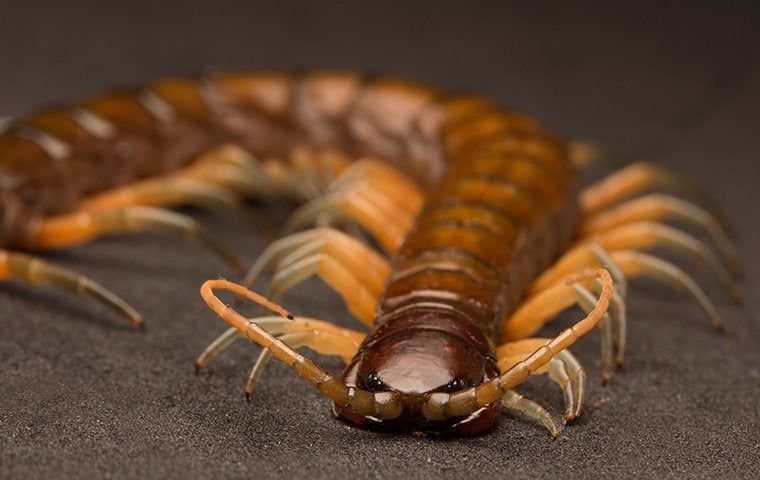


Centipede Identification & Prevention

What are centipedes?
Centipedes and millipedes are arthropods and commonly migrate into our homes, searching for a damp place to live. We refer to these pests as "occasional invaders." They live most of their lives outside but occasionally use our homes and other man-made structures as a place of respite.
The name centipede means "100 legs"; however, that number varies; most centipedes have between 15 and 191 pairs of legs. A centipede has a segmented worm-like body that is brown and flattened from top to bottom. Each body segment contains one pair of legs.
Use this pest guide to learn about centipedes and keep unwanted pests out of your home.
Are centipedes dangerous?
Certain centipedes can bite humans. They bite to defend themselves from being squished or otherwise harmed. While their bites aren't particularly dangerous, they can be quite painful; think bee sting.
Why do I have a centipede problem?
Both millipedes and centipedes prefer to live outside in dark, damp areas like under mulch, woodpiles, brush piles, fallen trees, landscaping ties, and rocks. Often our Omaha yards offer them the perfect habitat to call home.
Because they have high moisture needs, they will migrate to an environment that better suits their needs if their outdoor habitat becomes too hot and dry. Millipedes and centipedes living near the perimeter of our homes often migrate into our houses. They enter at ground level through small openings they find in the foundation or gaps under basement doors.
Where will I find centipedes?
The high moisture needs of millipedes and centipedes cause them to inhabit the naturally damp areas of our homes.
Basements, crawl spaces, cabinets under sinks, and storage boxes are places most likely to become a home to these leggy invaders.
Finding centipedes in your home is unpleasant. However, the bigger problem is that if they are getting into your house, so can other types of pests. When pests like cockroaches, spiders, and termites get into your home, they can cause serious problems like structural damage, food contamination, and the spread of diseases.
How do I get rid of centipedes?
If you are finding centipedes, millipedes, or other common household pests in your home, the best solution is to partner with a professional that can offer local pest control.
Our service specialists at Quality Pest Solutions are committed to providing our clients with peace of mind knowing their homes are free of pests. We will solve your home's pest problems using cutting-edge technology and effective treatments.
Reach out today to learn about effective pest control in Omaha.
How can I prevent centipedes in the future?
You can do a few things in and around your home to help avoid issues with centipedes. One of the best steps you can take is to regularly vacuum your house to dislodge and remove these pests. To keep centipedes from entering your home, inspect its exterior and seal any cracks you discover in the foundation. It is also important to reduce excess moisture in your home by quickly repairing leaky pipes, ensuring it has good ventilation, and using dehumidifiers.


Our Values, Your Peace of Mind
Why Choose Quality Pest Control?
-
Client-Focused Care
At Quality Pest Control, we pride ourselves on providing you with service that meets your needs. We take the time to listen to you and work with you to create a pest control plan that delivers the solutions you want.
-
Local Expertise
Quality Pest Control has been serving Omaha and the surrounding areas since 1996. We know the pests in our region and the most effective ways to treat them in order to eliminate and prevent them on your property.
-
Customized Services
No two pest control issues are exactly the same, so no two pest control plans should be either. We provide individualized treatment plans to every client we work with so that you receive the services you need for effective results.